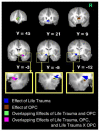Early life stress and trauma and enhanced limbic activation to emotionally valenced faces in depressed and healthy children
- PMID: 24954829
- PMCID: PMC4086855
- DOI: 10.1016/j.jaac.2014.04.013
Early life stress and trauma and enhanced limbic activation to emotionally valenced faces in depressed and healthy children
Abstract
Objective: Previous studies have examined the relationships between structural brain characteristics and early life stress in adults. However, there is limited evidence for functional brain variation associated with early life stress in children. We hypothesized that early life stress and trauma would be associated with increased functional brain activation response to negative emotional faces in children with and without a history of depression.
Method: Psychiatric diagnosis and life events in children (starting at age 3-5 years) were assessed in a longitudinal study. A follow-up magnetic resonance imaging (MRI) study acquired data (N = 115 at ages 7-12, 51% girls) on functional brain response to fearful, sad, and happy faces relative to neutral faces. We used a region-of-interest mask within cortico-limbic areas and conducted regression analyses and repeated-measures analysis of covariance.
Results: Greater activation responses to fearful, sad, and happy faces in the amygdala and its neighboring regions were found in children with greater life stress. Moreover, an association between life stress and left hippocampal and globus pallidus activity depended on children's diagnostic status. Finally, all children with greater life trauma showed greater bilateral amygdala and cingulate activity specific to sad faces but not the other emotional faces, although right amygdala activity was moderated by psychiatric status.
Conclusions: These findings suggest that limbic hyperactivity may be a biomarker of early life stress and trauma in children and may have implications in the risk trajectory for depression and other stress-related disorders. However, this pattern varied based on emotion type and history of psychopathology.
Keywords: child; early life stress; early life trauma; emotion; fMRI.
Copyright © 2014 American Academy of Child and Adolescent Psychiatry. Published by Elsevier Inc. All rights reserved.
Figures





Comment in
-
Here/In this issue and there/abstract thinking: "80 billion dollars, every year".J Am Acad Child Adolesc Psychiatry. 2014 Jul;53(7):711-2. doi: 10.1016/j.jaac.2014.04.016. J Am Acad Child Adolesc Psychiatry. 2014. PMID: 24954817 No abstract available.
References
-
- Juster RP, McEwen BS, Lupien SJ. Allostatic load biomarkers of chronic stress and impact on health and cognition. Neurosci Biobehav Rev. 2010 Sep;35(1):2–16. - PubMed
-
- Kuramochi M, Nakamura S. Effects of postnatal isolation rearing and antidepressant treatment on the density of serotonergic and noradrenergic axons and depressive behavior in rats. Neuroscience. 2009 Sep 29;163(1):448–455. - PubMed
-
- Czeh B, Simon M, Schmelting B, Hiemke C, Fuchs E. Astroglial plasticity in the hippocampus is affected by chronic psychosocial stress and concomitant fluoxetine treatment. Neuropsychopharmacology. 2006 Aug;31(8):1616–1626. - PubMed
Publication types
MeSH terms
Substances
Grants and funding
LinkOut - more resources
Full Text Sources
Other Literature Sources
Medical

